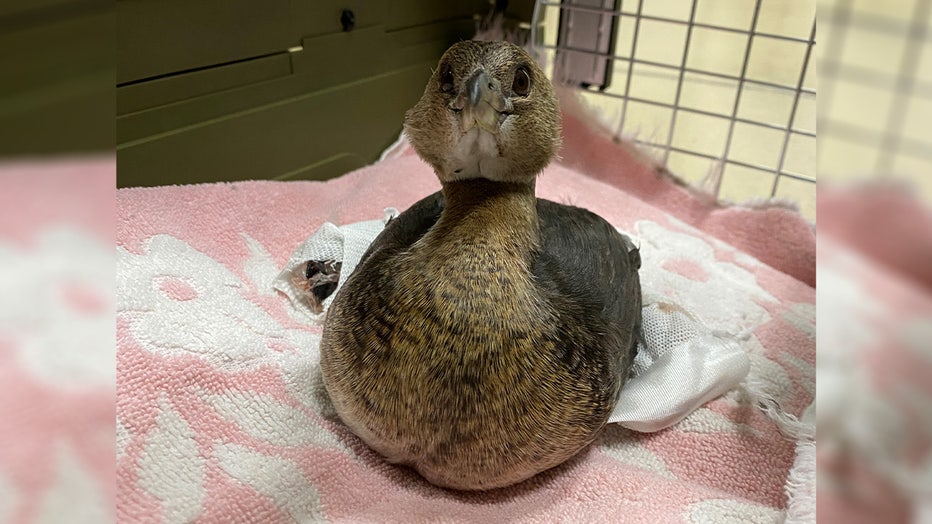Loons are falling from the sky in Wisconsin

Loons are falling from the sky in Wisconsin
Atmospheric conditions at high altitudes are causing ice to build up on migrating loons? bodies, causing them to land in dangerous situations, according to the Raptor Education Group. The Raptor Education Group, located in Antigo, Wisconsin, near Wausau, says they?ve received several calls this week of people finding loons stranded on the ground.
ANTIGO, Wisconsin (FOX 9) - Atmospheric conditions at high altitudes are causing ice to build up on migrating loons’ bodies, causing them to land in dangerous situations, according to the Raptor Education Group.
The Raptor Education Group, located in Antigo, Wisconsin, near Wausau, says they’ve received several calls this week of people finding loons stranded on the ground.
A photo the group shared on Facebook shows a loon that landed in a cow yard in northern Wisconsin. That farmer called the Raptor Education Group, which was able to take the loon and nurse it back to health.
The group says this can be a dangerous, even deadly situation for loons. Loons can’t walk on land and can only take off from water. So if they land on the ground, they can’t get back in the air.
The Raptor Education Group says the flight and weather conditions this week seem to be causing a "loon fallout." On Friday morning, representatives for the group said they were back out in the field trying to help five more stranded loons they were notified about.
The group says people who find loons on land should not try to take them to small bodies of water. They say loons have sharp beaks and can be defensive. Plus, small bodies of water may not be large enough for the loons to take off from. The Raptor Education Group says loons need about a quarter of a mile of water to take off.
The group says getting the word out about "loon fallout" on social media is having a big impact. They say many people are learning for the first time that it’s not safe for loons to be stranded on land. That’s causing people who find loons to report them to the group so they can rescue them.
Loons and grebes in Minnesota
The Wildlife Rehabilitation Center (WRC) did not admit any loons on Thursday or as of Friday afternoon, but Brittney Yohannes, the communications and development director, says it's common each spring for the WRC to receive loons and grebes that haber become stranded on roads and parking lots.
So far this month, the WRC has admitted six pied-billed grebes, including one Friday morning. All the animals were found stranded on roads and parking lots.

A grebe who is in the care of the Wildlife Rehabilitation Center of Minnesota. (Wildlife Rehabilitation Center of Minnesota)
"Imagine looking at the ground from above, from the perspective of a migrating bird. A wet road might look like a large, dark lake," Yahonnes told FOX 9. "Unfortunately once a loon or grebe lands, they become stranded for two reason: they cannot take flight without a large runway of open water, and their feet are set so far back on their body that they can only scoot themselves short distances. Their anatomy makes them excellent swimmers, but they are almost disabled on land."
When loons and grebes make these hard landings, many are injured. The most common injuries the WRC sees include road rash on their feet and fractured keel bones, legs and wings.

A grebe with bandages on its feet. (Wildlife Rehabilitation Center of Minnesota)
"If you find a stranded loon or grebe, you should bring it to a licensed wildlife rehabilitator so it can receive an exam and treatment for any injuries," Yahonnes said.
The Raptor Education Group is encouraging people who find loons to call them at 715-623-4015 or contact Loon Rescue at 715-966-5415. In the Twin Cities metro, people can call the University of Minnesota Raptor Center at 612-624-4745 or the Wildlife Rehabilitation Center of Minnesota at 651-377-8905.
The common loon is the Minnesota state bird. According to the Minnesota DNR, around 12,000 loons migrate to Minnesota every year, making Minnesota the state with the second most loons, behind Alaska. The DNR also estimates loons can live for around 30 years.

